Non-Toxic Hand Soap Guide

When I was growing up, my parents insisted that I wash my hands first thing upon coming home from school or playing outside. In addition, hand washing was a must before every meal. The question, “Have you washed your hands?” was common in the households of that time, but I didn’t give a second thought to it then. I just did it, because my parents told me to, and it became a habit that I brought into my adult life. Now that I know why it is important to wash hands, I want my son to become as diligent at hand-washing as I was.
In 2016, the FDA admitted that there was no proof of the effectiveness of antibacterial soap. The CDC advises us to wash hands with plain soap and water for at least 20 seconds. Therefore, in this post, we will talk about safe hand soap.
You will find out what constitutes the best hand soap among the suggested non-toxic liquid hand soap options. Also, read on to learn which liquid soaps without synthetic fragrances and toxic chemicals I like the most!
Non-Toxic Hand Soap Guide
In this blog post, I focus on liquid hand soap. For non-toxic bar soap, please refer to my post 9 All-Natural Soaps You Will Love.
For starters, how do we decide that a soap is safe? There is only one way – to look at its list of ingredients, not at its brand name or advertisements. The length of the list of ingredients may already tell you something about its safety, which is particularly true in the case of soap. To clarify, the best hand soap out of all the non-toxic hand soaps normally has a short list of ingredients. But before we discuss safe hand soap, let’s talk about hand soap to avoid.
To make it easier for you to follow, I have arranged hand soap into three categories: “not a fan,” “better,” and “best.” It is helpful to see the big picture so you can make an informed decision.
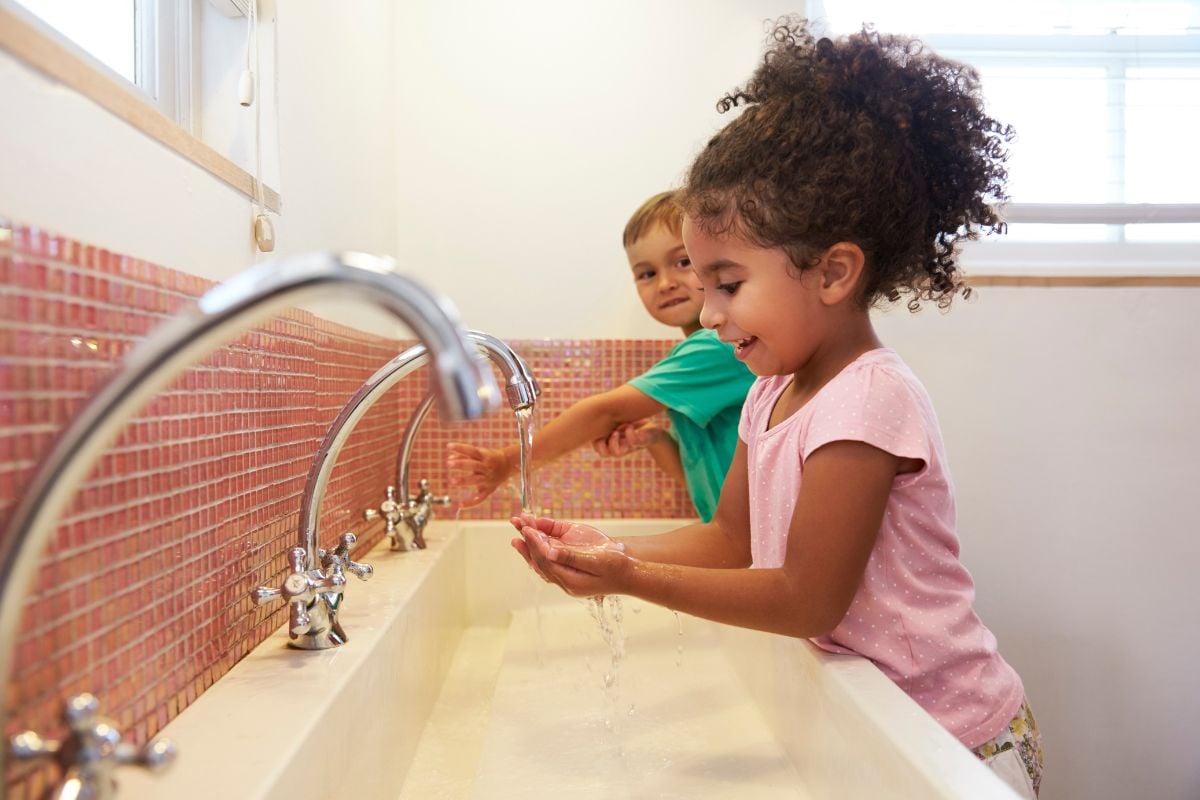
“Not A Fan” Soap Category
Here are the soap products that I placed in the “not a fan” category based on their ingredients as of April 2024 and the reason for the placement.
| Category | Soap Name | Concerning Ingredients |
| Not A Fan | Dial Gold Anti-Bacterial Deodorant Bar Soap | – benzalkonium chloride – fragrance – fragrance isolates (e.g., linalool, coumarin) – synthetic dyes (e.g., red 4, yellow 8) |
| Not A Fan | Dove Care & Protect Antibacterial Foaming Hand Wash | – benzalkonium chloride – ethoxylated ingredients – iodopropynyl butylcarbamate – fragrance – fragrance isolates (limonene, linalool) |
| Not A Fan | Method Waterfall Foaming Hand Wash | – fragrance – synthetic dyes (blue 1, yellow 10) – read my post about Method Cleaning Products |
| Not A Fan | Mrs. Meyer’s Liquid Hand Soap | – fragrance – read my post about Mrs. Meyer’s Cleaning Products |
| Not A Fan | Purell Healthy Soap High Performance Foam Hand Wash | – ethoxylated ingredients – fragrance |
| Not A Fan | Softsoap Antibacterial Liquid Hand Soap | – benzalkonium chloride – ethoxylated ingredient – fragrance – iodopropynyl butylcarbamate – methylchloroisothiazolinone – methylisothiazolinone – synthetic dyes (e.g., red 40, yellow 5) |
| Not A Fan | Uline Antibacterial Hand Soap | – benzalkonium chloride – ethoxylated ingredients – fragrance – synthetic dyes (e.g., red 33, yellow 5) |
As you can see, the common ingredients that caused me to place these soap products into the “not a fan” category are as follows:
- benzalkonium chloride
- ethoxylated ingredients
- fragrance and/or fragrance isolates
- iodopropynyl butylcarbamate
- methylchloroisothiazolinone
- methylisothiazolinone, and
- synthetic dyes.
The “best” hand soap will definitely not have these potentially toxic ingredients. Let’s talk about them a bit more to see why they are concerning when used in personal care products.
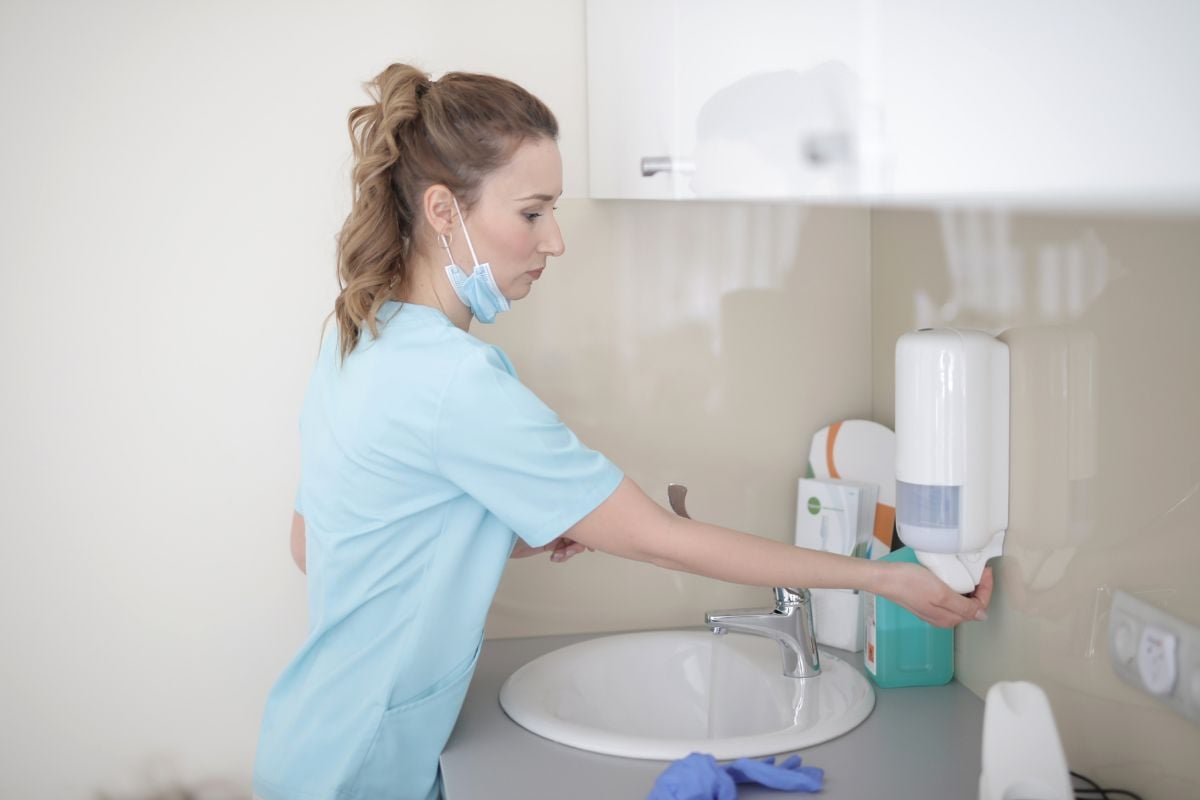
Benzalkonium Chloride
To begin, in 2016, the FDA banned some antibacterial chemicals, such as triclosan, from use in antibacterial soap sold over the counter. The Skin Deep database gives triclosan a rating of 7-8 (with 10 as the most toxic), depending on usage, and characterizes it as triggering allergies and immunotoxicity.
But there is another potentially toxic ingredient that is contrary to the definition of non-toxic hand soap. It is benzalkonium chloride, and it is still allowed. Benzalkonium chloride has a rating of 6 and arouses a high concern of allergy and immunotoxicity. Serving as a foaming and cleansing agent or as an antimicrobial preservative, it is a well-recognized irritant (source).
In addition, there is evidence that it may cause contact allergy even at concentrations as low as 0.1% (source). Benzalkonium chloride decreased fertility in both sexes of mice, even when it was used just to clean their cages (source). (Also, read my blog post about WaterWipes Baby Wipes to be sure not to expose your little ones to this ingredient.)
Ethoxylated Ingredients
As for ethoxylated ingredients, there may be a risk of contamination with carcinogenic 1,4-dioxane. Ethoxylated ingredients are those whose names have PEG-, -eth, and polysorbate in them. Such ingredients result from the process of ethoxylation which utilizes carcinogenic ethylene oxide and creates 1,4-dioxane that can be left behind in the product.
One of the common ethoxylated ingredients in personal care products is sodium laureth sulfate (SLES). It is often confused with sodium lauryl sulfate (SLS) which is actually not an ethoxylated ingredient.
Fragrance
There is a loophole in the law that allows companies not to disclose the ingredients in fragrance. And fragrance is associated with allergies and endocrine (hormone) disruption. Even a so-called “natural fragrance” raises a lot of questions. Thus, in my post about natural fragrance I explain why fragrance is not as innocent as it seems. I also address the difference between fragrance isolates that are known allergens (e.g., linalool, limonene, coumarin) and essential oils and fragrance oils.
Iodopropynyl Butylcarbamate
This preservative is on the American Society of Contact Dermatitis list as one of the core allergens. Reportedly, even in concentrations as low as 0.1%, it may cause dermal irritation or contact allergy. Furthermore, in the EU, it is under assessment for hormone disruption.
Although preservatives are a must for liquid handwashing products to prevent the growth of mold and bacteria, it is possible to use safer preservatives.
Methylchloroisothiazolinone And Methylisothiazolinone
These preservatives are common in conventional cleaning and personal care products. However, they arouse concerns associated with contact dermatitis and skin sensitization. Both Canada Health and the EU Scientific Committee on Consumer Safety (SCCS) believe that it is not safe to use any of these in leave-on products in any amounts. As for rinse-off products, the maximum concentration should not exceed 0.0015%.
You can learn more about methylchloroisothiazolinone, methylisothiazolinone, and benzisothiazolinone in my posts devoted to these potentially toxic chemicals.
Synthetic Dyes
In addition to heavy metal residues, synthetic dyes may contain carcinogenic and endocrine-disrupting byproducts of petroleum. Plus, some dyes are linked to carcinogenicity, genotoxicity, and hypersensitivity (source). You can read more about that in my post Are There Any Heavy Metals in Makeup?.

“Better” Hand Soap
The “better” group includes the liquid soaps listed in the table below.
| Category | Soap Name | Concern |
| Better | EO Unscented Hand Soap | cocamidopropyl hydroxysultaine |
| Better | Everyone Hand Soap | – cocamidopropyl hydroxysultaine – phenoxyethanol |
As follows from the table, the soaps above do not contain any of the ingredients listed in the “not a fan” category as concerning ingredients. Yet, they have some ingredients that make these products fall short of the “best” hand soap category, namely:
- cocamidopropyl betaine
- cocamidopropyl hydroxysultaine, and
- phenoxyethanol.
Here is what you should know about these ingredients.
Cocamidopropyl betaine
First, cocamidopropyl betaine is a surfactant that makes cleansing products lather. It is known to cause allergic skin reactions in some people (source). Also, the American Society of Contact Dermatitis lists cocamidopropyl betaine as one of the core allergens, even in concentrations as low as 1% (source). Due to high rates of cases involving allergic reactions, the American Contact Dermatitis Society named it “Allergen of the Year” in 2004 (source). Moreover, under certain conditions, it may break down and form nitrosamines associated with increased cancer risks. The Skin Deep database rates cocamidopropyl betaine at 1-5, depending on use (with 10 as the most toxic).
Cocamidopropyl hydroxysultaine
Second, cocamidopropyl hydroxysultaine is a close relative of cocamidopropyl betaine and another one of many newly emerging surfactants. Even though the Skin deep database rates cocamidopropyl hydroxysultaine at 1 (with 10 as most toxic), I have reasons to disagree with this rating. To make an informed decision about this ingredient based on the latest research into its safety, please head to my post Is Cocamidopropyl Hydroxysultaine Safe?.
Phenoxyethanol
I call phenoxyethanol a “middle-of-the-road” preservative in my Savvy Consumer Superpower e-book. While it does not pose health threats, I believe that it does not belong in the “best” hand soap category. The main reasons I have my doubts about it are as follows. First, it may cause an allergic reaction in some people, and second, I am concerned about its derivation and manufacturing process. You can read more about it in my post called Phenoxyethanol in Skin Care.

9 “Best” Non-Toxic Liquid Hand Soaps
Most of the safe hand soap options in the “best” category are made through the process of saponification of plant oils. Therefore, they do not need surfactants and preservatives, many of which are linked to various health issues, including endocrine disruption, organ toxicity, allergies asthma, neurotoxicity etc. (You can learn more about the eco-friendly process of saponification in my post How to Buy a Truly Non-Toxic Soap.)
And those non-toxic hand washes among the suggested options that are not made by saponification have the safest and mildest surfactants and preservatives, in my opinion. In other words, they are not associated with hormone disruption, skin irritation, lung and respiratory issues and neurotoxicity.
Additionally, many of the botanical ingredients in the liquid soaps in the “best” category are organic. Plus, they have no synthetic fragrances whose ingredients in conventional soaps are often undisclosed. Rather, if there is a scent in some of these products, it comes from essential oils only.
The great news is that there are quite a few options to choose from. My favorite ones are as follows:
- Branch Basics Gel Hand Soap (READ15)
- MamaSuds Hand Soap (IRLFY10)
- Natural Sloth Liquid Hand Soap (READ10)
- Primally Pure Hand Soap (READLABELS10)
- Pure Haven Moisturizing Hand Soap
In addition, you can consider these options:
- Dr. Bronner’s Castile Soap Unscented
- Dr. Bronner’s Organic Sugar Soap
- Kosmatology Foaming Hand Soap
- Vermont Foaming Soap Unscented.
Let’s talk about them more.
Branch Basics Gel Hand Soap
This safe soap is not made through the process of saponification, but it contains the safest (in my opinion) glucoside surfactants and leuconostoc/radish root ferment filtrate and sodium phytate preservatives. The aloe leaf juice and chamomile flower extract are organic. It also contains meadowfoam oil to soothe and hydrate your skin with every wash and has no essential oils.
It is great that Branch Basics Gel Hand Soap (READ15) comes in a glass bottle with a pump that you can keep and just order a refill next time. The soap is rather concentrated and a little goes a long way. I also love the fact that because it is gel, it does not dissipate immediately. Hence, it is easier to fulfill the 20 second hand-wash requirement.
I have been using Branch Basics non-toxic products for a while now and can confirm that they are very economical and effective. So, be sure to check out my review of Branch Basics Safe Cleaning Products.
MamaSuds Hand Soap
The Liquid Hand Soap by MamaSuds (IRLFY10) is the result of the manufacturing process of saponification with just two ingredients. While its scented version contains a lemon essential oil, the unscented one has no essential oils in it.
You may also like such eco-friendly products by MamaSuds as MamaSuds Bar Soap, MamaSuds All-Purpose Cleaner, MamaSuds Dishwasher Powder, and MamaSuds True Castile Soap.
Natural Sloth Liquid Hand Soap
Most of the ingredients in the Natural Sloth Liquid Hand Soap (READ10) are organic, including cocoa butter, castor oil, and coconut oil. The cheerful scent comes from essential oils only. Plus, this safe hand soap contains dead sea salt whose high mineral content helps accelerate the soap’s curing process, which results in a longer-lasting product.
I like the fact that it provides luxurious lather that gently cleanses and preserves moisture while washing away dirt, which leaves your skin revitalized, nourished, and smooth.
Primally Pure Liquid Hand Soap
This eco-friendly soap is made through the process of saponification and has a variety of scents coming from essential oils. The botanicals used in this non-toxic hand soap are either organic or wildcrafted. I especially like the fact that Primally Pure Liquid Hand Soap (READLABELS10) is packaged in a recyclable glass pump bottle.
Pure Haven Moisturizing Hand Soap
Like Branch Basics hand soap, Pure Haven Moisturizing Hand Soap is not made by the process of saponification. Instead, it uses one of the mildest glucoside surfactants and leuconostoc/radish root ferment filtrate as a preservative. It is pH-balanced, moisturizing, and scented with organic sweet orange and lemon essential oils. It smells divine!
Because it is a gel hand soap, you can wash the hands longer as it does not dissipate from your hands too quickly.
Importantly, I trust Pure Haven as a company because they value my advice on the ingredient selection. Plus, they fully control their entire manufacturing process, from the incoming water to machine cleaning. They also assure that their ingredients are of high purity and quality. For your information, Pure Haven also has bar soap that I like very much as well. You can read my full review of Pure Haven products here.

Dr. Bronner’s Castile Soap
This company offers a variety of scented castile soap options, but I prefer unscented products in general. In my opinion, the scented versions have very strong scent. Also, watch out for a scented version that contains “natural fragrance” as an ingredient because it’s a mixture of undisclosed ingredients.
Dr. Bronner’s Castile Soap Unscented (10% or $10 off) is made by saponification with organic plant oils, including coconut oil, palm kernel oil, olive oil, hemp oil, and jojoba oil.
Dr. Bronner’s Organic Sugar Soap
The Dr. Bronner’s Organic Sugar Soap (10% or $10 off) is also made through the process of saponification. It contains organic sucrose, organic white grape juice, organic coconut oil and palm kernel oil as well as organic olive oil, organic shikakai powder, organic hemp and jojoba oils.
Kosmatology Foaming Hand Soap
This non-toxic foaming hand soap is made by the process of saponification of organic oils, such as olive oil, coconut oil, and palm kernel oil. Further, scented with essential oils only, Kosmatology Foaming Hand Soap comes in many different mild scents. Besides, the soap foams well, smells divine, and is not drying for the skin. What’s more – refills are available on the website!
Vermont Foaming Soap
Also made by the process of saponification with organic oils of olive, sunflower, jojoba and shea butter, Vermont Foaming Soap Unscented comes in a gallon-size bottle. So, it will last you a long time!
Summary Of The Non-Toxic Hand Soap Guide
If You Are Looking For Non-Toxic Hand Soap, Choose Those Options That Are Either Made Through The Process Of Saponification Or Have Glucoside Surfactants And Safe Preservatives And Contain No Synthetic Fragrances.
To sum up, I would avoid conventional hand soap made with potentially toxic ingredients, such as:
- benzalkonium chloride
- ethoxylated ingredients
- fragrance and/or fragrance isolates
- iodopropynyl butylcarbamate
- methylchloroisothiazolinone
- methylisothiazolinone, and
- synthetic dyes.
My favorite liquid soaps that I consider the “best” safe hand soap options include:
- Branch Basics Gel Hand Soap (READ15)
- MamaSuds Hand Soap (IRLFY10)
- Natural Sloth Liquid Hand Soap (READ10)
- Primally Pure Hand Soap (READLABELS10), and
- Pure Haven Moisturizing Hand Soap.
If you are looking for non-toxic bar soap, be sure to check out my post about 9 All-Natural Soaps You Will Love.
Also, feel free to browse my non-toxic product shop for safe options for skincare and cleaning products as well as visit the I Read Labels For You blog for tons of smart and fun information on healthy living. If you need additional help, you are always welcome to turn to me for assistance and/or download any of my helpful e-books.
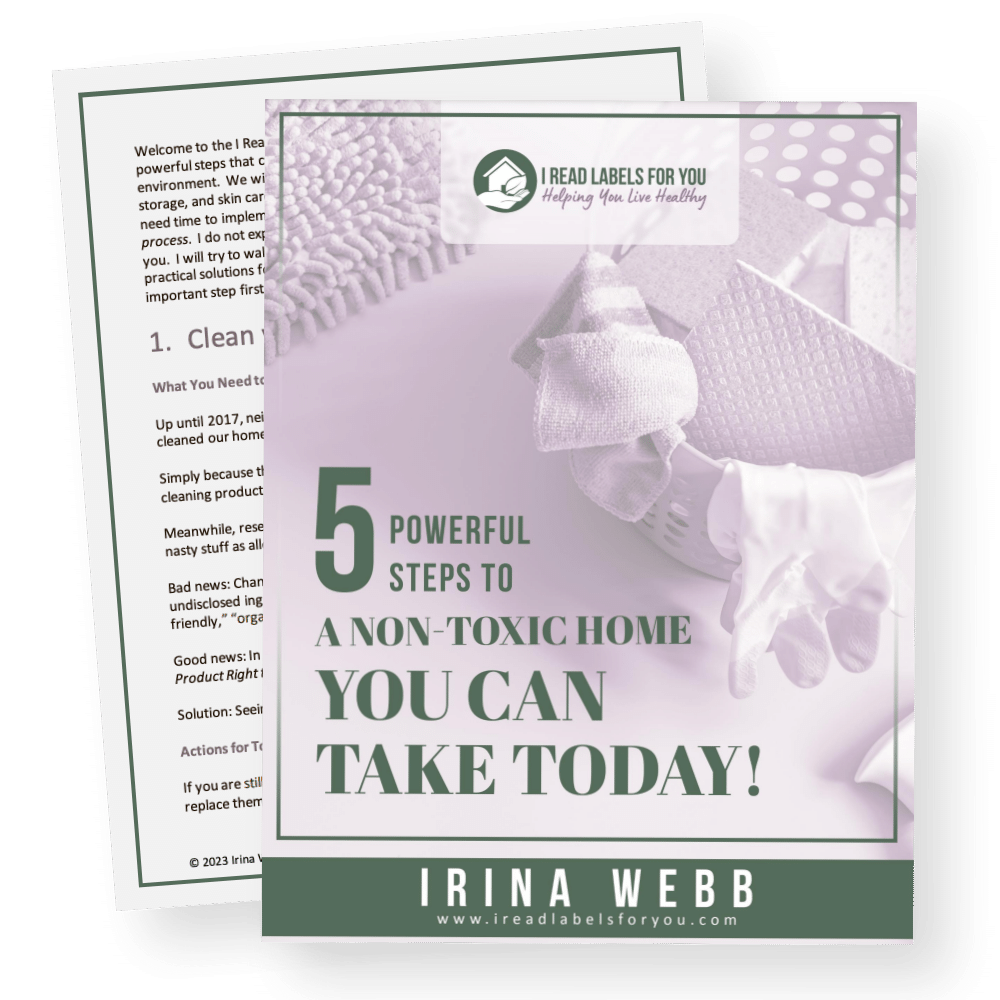
Download The Free Guide!
5 Powerful Steps To A Non-Toxic Home
Join our informed consumer community and get our free guide the “5 Powerful Steps To A Non-Toxic Home”.

 Written by
Written by 
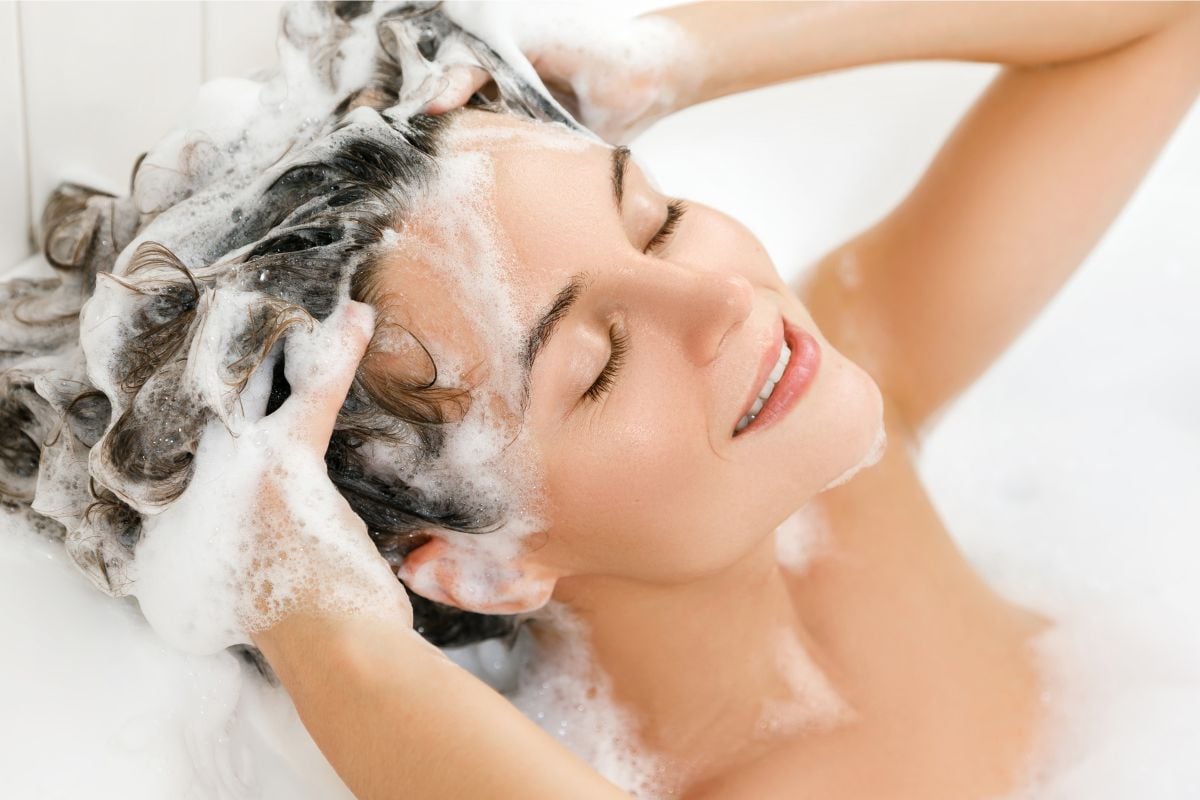

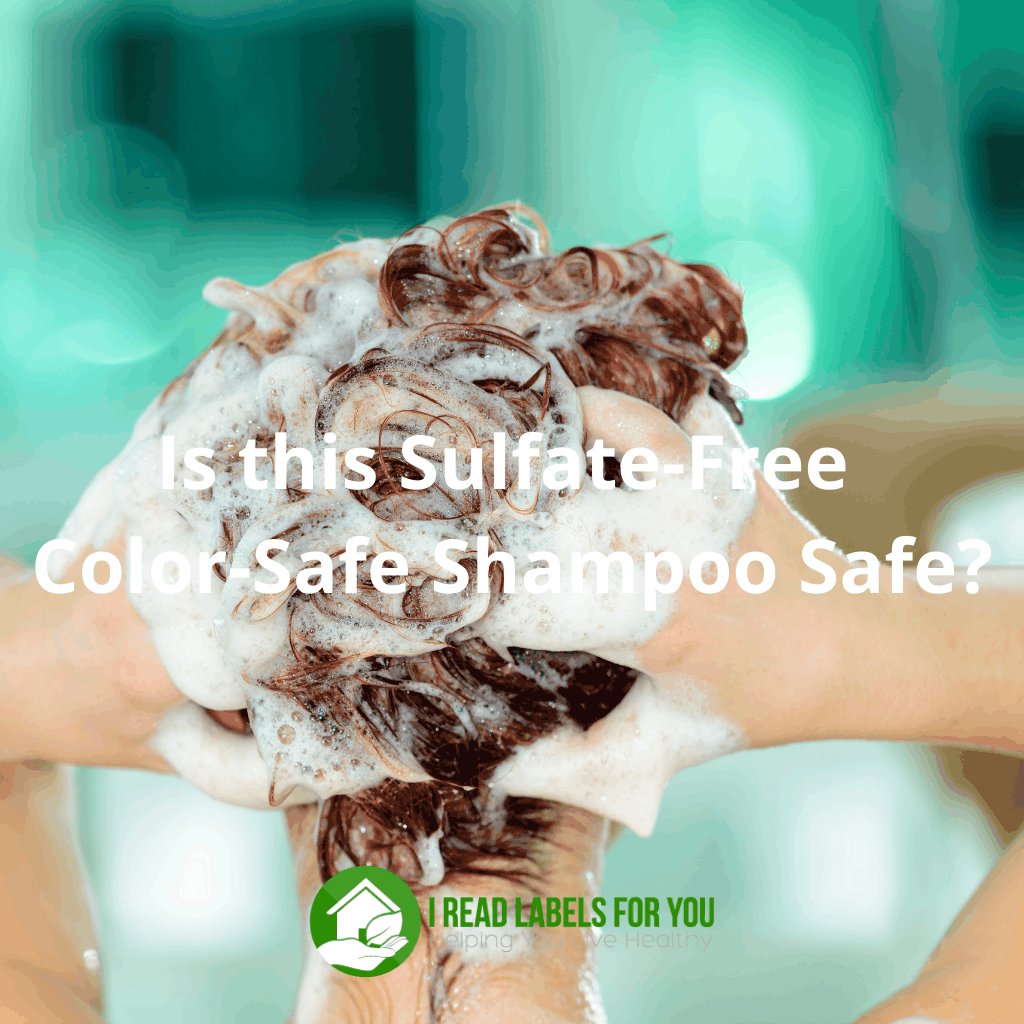
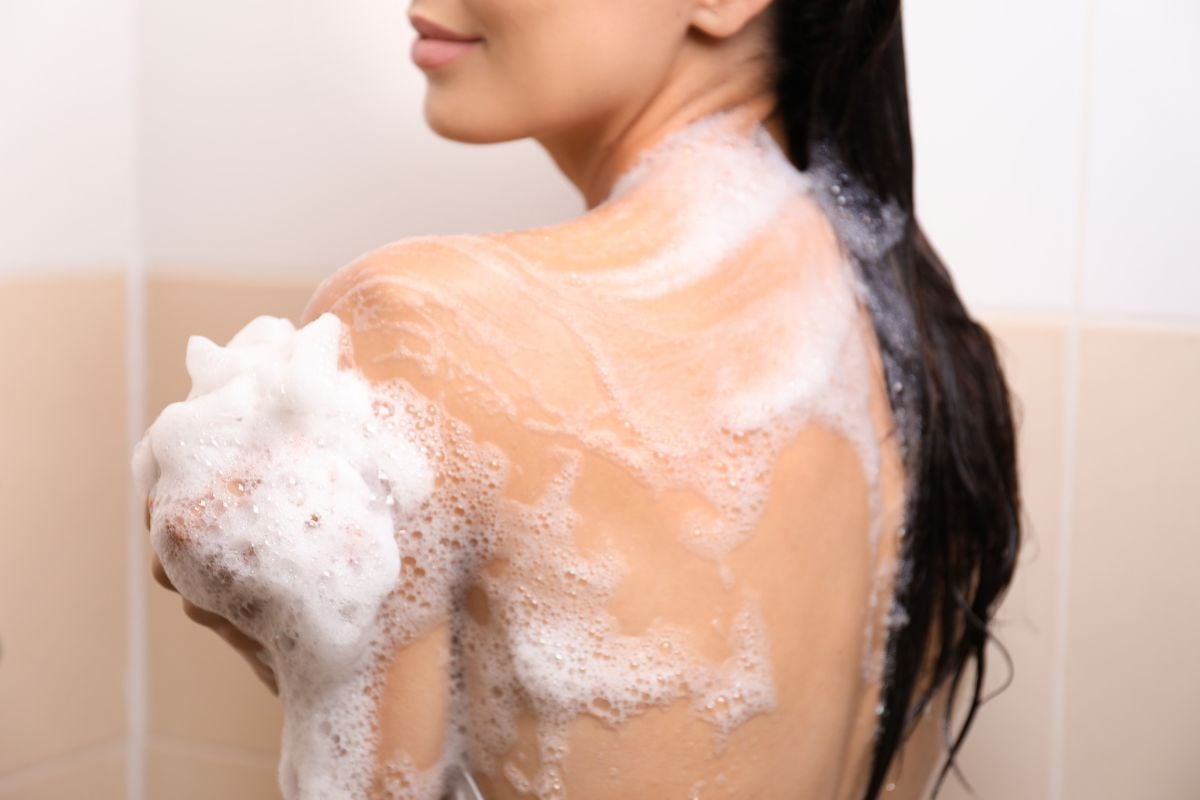
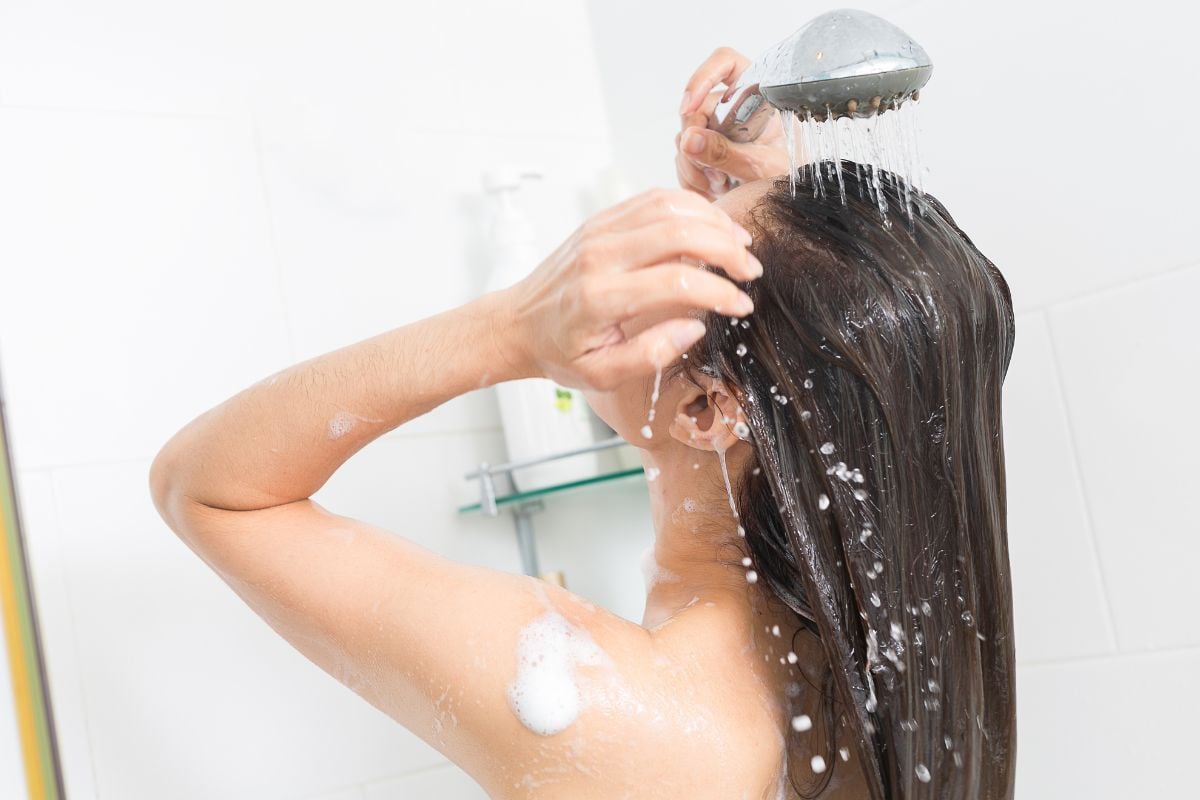
Dear Irina,
Many thanks for your helpful piece.
I live in the UK and am allergic to seeds, sunflower oil etc; so can’t use many of these, but here are three soaps that I would like to ask you about:
Co-op Pure Vegetable Soap, Colour and Fragrance Free; Ingredients: Sodium Palmate, Sodium Palm Kernelate, Water (Aqua), Glycerin, Sodium Chloride, Tetrasodium Glutamate Diacetate, Citric Acid, Sodium Hydroxide
Oliva Pure Olive Oil Soap; Ingredients: Saponified Olive Oil, Water, Mineral Salts
Faith in Nature Unfragranced Seaweed Soap; Ingredients: Sodium palmate, Sodium cocoate, Aqua, Glycerin, Ascophyllum nodosum powder, Sodium chloride, Sodium citrate
Best wishes,
Nihan
Hi, Nihan! The ingredients for these products look fine. If you feel like you need a personal consultation, Irina will be more than happy to help you: https://ireadlabelsforyou.com/services/
I’ve bought some gelo handsoap products, but I’m having a hard time finding information on whether they are safe or not. Do you have any insight on this product?
Thanks for your article and help!
Hi Kelsey!
We appreciate your interest! Irina will be happy to help you with your question in a private consultation here: https://ireadlabelsforyou.com/services/
Can you recommend all of the Dr. Bronner’s sugar soap scents? Or should we just stick to the unscented baby version. Interested in the lemongrass scent but ewg rates it a 3.
Hi Ty! Thank you for your question! For babies our website recommends unscented options. For adults essential oils are ok and mostly a matter of personal preference and sensitivity. We hope this helps!
Can you recommend all the scents for the Dr. Bronner’s sugar soap? I.e. are they all considered best category and safe to use?
Hello Mitch! We appreciate your interest! Irina will be happy to help you with your question in a private consultation: https://ireadlabelsforyou.com/services/
On my previous email to you, I may have deleted it accidentally! Please respond to my questions as follows:
I, very much, prefer a liquid hand soap. This is the best way for me to be assured that no others fingers and hands have used it. Please comment for I want to know what your opinion or opinions are.
I am, very much, look forward to your immediate response. Thank you so much!
Hi, Pat: I am not sure what your question is. ~Irina
Hi, I’m guessing that she was asking if you have any liquid hand soaps that you recommend as much as you do the above bar soaps.
I too prefer liquid.
Hi John! Thank you for your question! You can check out the “healthy personal care” category of our website shop for some safe liquid hand soap options: https://ireadlabelsforyou.com/product-category/healthy-personal-care/
Any recommendations for a liquid hand soap I can use at work that does NOT contain compositea mix, decal glycoside, formaldehyde, linalool, propolis and quaternium-15?
Thanks in advance!
Hi, Mary! Thank you for your interest! We hope you can find the right product in our shop: https://ireadlabelsforyou.com/product-category/healthy-personal-care/
Great article!
I use Dr. Bronner’s Organic Sugar Soap and I like it. It’s moisturizing and iit also has a pleasing smell.
Stay safe and healthy!
Cheers!
I used Dr. Bronner’s Castile soap (diluted) for years without a problem. However, when I developed allergy-induced atopic dermatitis/eczema, this soap further exacerbated my skin condition. Doctor recommended Vanicream/Cetaphil. Vanicream worked, but I prefer as natural as I can get. After a lot of research, I am now using Everyone 3-in-1 soap after Acure discontinued their product.
Dear Madam/Sir,
Do you have a list of the best laundry detergents with the least/no toxic ingredients? Thank you for the above list of hand and body soaps which are safe.
Best regards,
Mark Harrington
Mark, my name is Irina… Not yet but you can visit my Shop and in the healthy cleaning section, you will find some detergents that I like: https://ireadlabelsforyou.com/shop/ You can also type your keyword in the search engine of the website to see what I have written on the subject. Does it help? ~Irina
Thank you for your research, Irina. I do a lot of research myself, so I appreciate how much work it is. I used a soap in your “best” category for years, until it started causing me problems. It was then that I realized how important it is to try and preserve the acid mantle of skin. Hence, I would add pH of the soap as a factor in how safe a soap is. The way soap is made, it is challenging to find something that has a good pH and non-toxic ingredients!
Hi, Anita: yes, pH is important but also the kinds of oil they use and whether they make sure that there is no free alkali left in the product. Also, superfatting helps with moisturization. pH alone is not a guarantee. ~Irina
Hi Anita,
I’m so sorry to hear that. I was going to buy one of them, thanks for your reminder about PH. Could you share which one caused you problem? I hope you have found something good for you.
Ladies, just a reminder that while pH matters, it is not the most important factor. A well made hand soap even with higher pH should work well. Also, I hope you can appreciate all the work I have done for you for free. If you are interested in pH, all you need to do is contact the companies and ask for pH. Please know that the more of us ask questions of the companies, the safer products we are going to have. Thank you for your understanding. ~Irina
You have an older post speaking of ph cleansers and how they are better for the microbiome of our skin and not to use soap because it’s highly alkaline .. so which one is it?
Hi, Penny: I think this is for you to decide. I post my research so you can use it to make an informed decision in your situation. And if you need help, you can always book a consultation. For my skin type and personal preferences, I decided that it is best to use saponified soap on my hands and a glucoside product on my face. However, everybody is different. There are people who are even allergic to glucosides or won’t buy those products because of plastic pollution. And so on. It sounds like you prefer to avoid saponified products altogether even from the use on your body, then you can choose the ones from the better category. In other words, nothing is black and white. I read research and form my opinions. You can read the same research and form a different opinion Does it help? ~Irina
What is your favorite or recommended liquid hand soap?
Hi, Gloria! Thank you for the question! The options we recommend are in our website shop. Please, check it out: https://ireadlabelsforyou.com/product-category/healthy-personal-care/